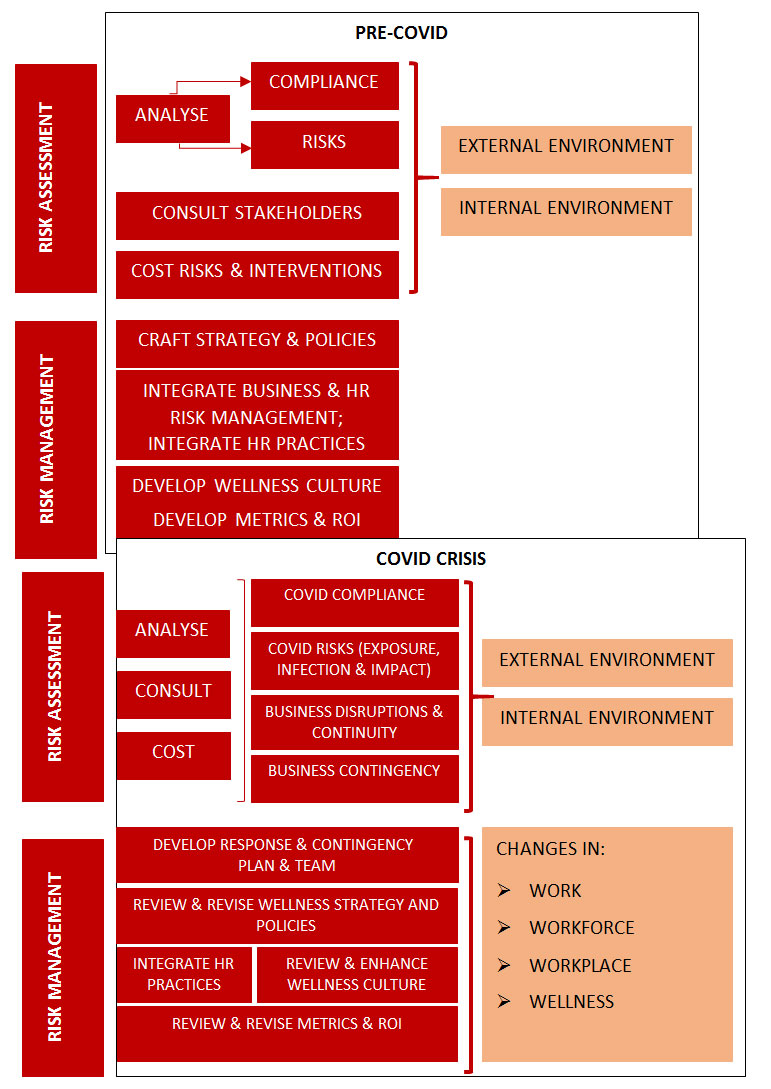There are many concerns, locally and globally, regarding employee wellbeing in relation to the COVID pandemic and the organisational responses to it, such as the management of work, workforce, and workplace during and post the pandemic. This includes the preparation and management of the workforce and workplace in accordance with legislation, regulations, and scientific advice; the shift to remote and flexible working; and the adoption of digital technologies. The survey conducted by the Chartered Institute of Personnel and Development (CIPD, 2020) is an illustration, for example, of the considerations on workplace technology.
These mounting concerns require a systematic and integrated approach, from the assessment to the management of employee wellbeing. This can be a daunting task for organisations given the complexities entailed and as they confront multifaceted challenges and crises. To make this a manageable task one can begin to identify the key dimensions and a structure or framework to address the various dimensions. For example, one could draw up a process flow and guideline. In this regard the SABPP HR Risk Management and Wellness Standards can be instructive. The below process flow and questionnaire is an illustration based on these Standards.
Process Flow
The figures below provide illustrative process flows that outline a possible end-to-end risk and wellness management process – from risk assessment, management to monitoring and evaluation. The first figure maps the process pre-COVID and the second the process for the COVID crisis and thereafter.

Questionnaire
The below questionnaire unpacks the above process flow. It provides an illustrative step-by-step process for addressing the various dimensions of wellness and to undertake the risk assessment, management, and monitoring and evaluation.
| Undertake a wellness risk assessment | Has the organisation conducted a wellness analysis and risk assessment prior to the COVID-19 pandemic?
Has the organisation conducted a wellness analysis and risk assessment prior to the COVID-19 pandemic? |
No
|
|
| Yes |
|
||
| Dimensions of wellness |
Consult with stakeholders to examine the above dimensions and the impact of the COVID-19 pandemic, and the organisation’s responses to it and the changes in work and workplace, will have on these dimensions:
High risk groups
High risk groups
High risk groups
|
||
| Formulate or revise the wellness philosophy, strategy and policy |
|
||
| Communication and engagement |
|
||
| Organisational adaptive capacity and resilience |
|
||
| Link with EVP |
|
||
| Metrics |
|
||
The above process flows and questionnaire illustrate the complexity of the task at hand as well as how it can be undertaken in a systematic and integrated approach. The HR practitioner needs to ensure that the HR practices are integrated and work in consonance to realise the strategic, tactical and contingency objectives of the organisation and serve the EVP and the needs of the employees.
—-
Dr Ajay Jivan is the SABPP Lead for Research, Product Development, and Universities. He is also a registered Psychologist and Director at Vantage Lab (https://vantage-lab.com/), which helps clients navigate the changing strategic landscape and co-evolve their leadership and human capital strategies, development and research.
References
CIPD. (2020). Workplace technology: The employee experience. Retrieved, 21 July 2020, from https://www.cipd.co.uk/knowledge/work/technology/workplace-technology-employee?utm_source=mc&utm_medium=email&utm_content=cipdupdate_08072020.EdL1_Tech_Report_2020&utm_campaign=cipd_update&utm_term=8247550




1 comment
COVID 19 has actually made people to be innovative, and after it has subsided and and gone for good there will be changes in many policies and procedures.
i am happy that i also contributed in curbing the pandemic in our company, and also reading some of SABPP`s news letter made me to augment.